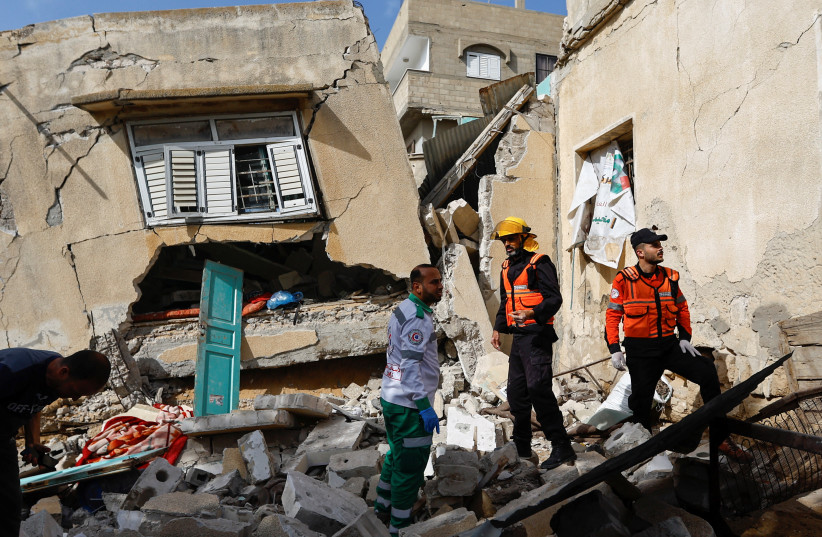The opening strike of Operation Shield and Arrow that killed three Palestinian Islamic Jihad commanders in Gaza last Monday has reignited the ongoing debate on the legality of targeted killings.
Israel, like other states, is bound to international law. Some of its obligations are due to treaties, but there is also customary IHL -- generally accepted practices by states, who treat the practice as if it were law. Israel has adopted the Geneva Conventions, save for the Additional Protocols, but the High Court of Justice sees them as customary law. This shows how important the repeated practices of other states are in IHL.
Targeted killings are a somewhat ill-defined term. There is no set definition under International Humanitarian Law (IHL). Some sources treat it as merely a softer term than assassination, still others describe it as a military strike against a specific person -- in particular that of terrorists.
The International Committee of the Red Cross says that targeted killing is "The intentional and premeditated use of lethal force, by a State or organized armed group against a specific individual outside their physical custody."
This, like other definitions, can be applied to most other applications of military force. It is not exclusive to a particular legal or illegal action.
In Israel, it generally refers to a policy of targeting of the top echelons of terrorist organizations. Yet this can also be seen as a natural military action in the course of war, rather than a distinct category under IHL.

How does international humanitarian law consider targeted killings?
There do exist tools within the IHL framework to determine the legality of a military strike.
There is little that differentiates the opening blow of Shield and Arrow from strikes conducted later in the operation, save for the ongoing launching of rockets from Gaza. This creates a question of military necessity, one of the main principles of IHL.
The IDF argues that there was an impending threat from the Islamic Jihad commanders, and this created military necessity to strike. Killing the commanders reduced the capabilities of the organization to conduct terrorist attacks.
Yet it could also be argued that it has become customary in IHL for terrorist leaders to demand killing over a more general threat posed to a state. It is disputed whether Osama Bin Laden presented an immediate threat to the United States of America when then-president Barack Obama ordered his killing. The US contended he was still operationally active, but cited no active field operation. There was little to no backlash over this action. The killing of Gazan PIJ leaders could likewise be seen as having degraded terrorist effort in part of a sequential attack, or war, against Israel and its citizens.
In the discussion of targeted killings, sometimes the question is one of distinction. Under this principle of IHL, one differentiate between civilians and combatants in attacks, and take necessary precautions to avoid civilian casualties.
The status of Gazan terrorists is a matter of debate. Some argue that terrorists are unlawful combatants, but retain the status of civilians. This means they are only considered combatants when they are directly involved in direct hostilities. In state armed forces, High ranking officers who do not fight and only command and plan far from the battlefield are generally considered legitimate targets. This likely means that the action of ordering and planning could be considered a direct hostile action.
Yet non-state armed groups are also bound by IHL in both international and non-international conflicts. These commanders were part of an organized military force that had a hierarchy, insignias and uniform. Many treat Gaza as a de facto state, and the terrorist organizations as de facto state military forces. Western states targeted leaders of the Islamic State with increasing regularity, treating them as if they were members of an opposing armed force of recognized combatants.
Unlike in the West Bank, it is difficult to argue that Gazans are under occupation, which would mean that they lack that unlawful combatants have the same protections in that state of conflict.
Some are quick to point out that even if there is no debate about whether Islamic Jihad commanders are legitimate targets under IHL as combatants, the Israeli strikes also took the lives of the terrorists' civilian family members.
This is a matter of applying the principle of proportionality. The military advantage of a strike must exceed the potential risk of damage to civilians. This is determined by a reasonable commander using the best information at the time.
It is difficult to determine without full access to the extent of the impending threat, and understanding how the commanders fit into the PIJ hierarchy, to determine if the value of the military degradation was greater than the risk to civilians.
These IHL principles of proportionality, distinction and military necessity should be applied to all such targeted killings -- as they are to all IDF military strikes.
Therein lies the problem with the debate about targeted killings: Despite discussion of premeditation and accuracy, the term is more of a nebulous pejorative used to cast aspersion on a military action rather than carefully explore and weigh the facts of the individual incident.
It has become a label for if one approves of a military strike against a terrorist or not. It is a label that applies to some states, like Israel, and rarely questioned when used by others.
